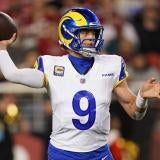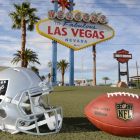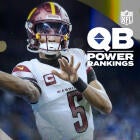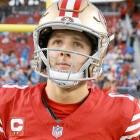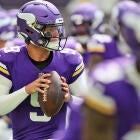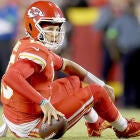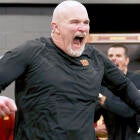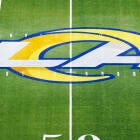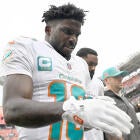The Las Vegas Raiders are the ninth team to relocate in the Super Bowl era, and this is the third time the Raiders franchise has moved in the past 38 years -- so they should be used to this. Just because a team relocates doesn't mean instant success, even though the long-term effects are immensely beneficial.
Las Vegas could be in for a tough first season, even if the franchise is destined to see better days ahead. In a new city, the first season is full of excitement, taking away the obsession of a win-loss record (even though the Raiders have a talented enough roster to make the playoffs in their first Las Vegas season).
Expectations for the Raiders shouldn't be sky high. Perhaps they can buck the trend of tough seasons in Year One. Here's a look at the inaugural season of all 16 franchises to relocate to a new city in NFL history:
Los Angeles Chargers (2017), from San Diego
The Chargers appeared doomed in that first season in Los Angeles. Not only was Philip Rivers coming off leading the league in interceptions (21), but the Chargers defense allowed the fourth-most points in the league. They also played in a soccer stadium that held just 27,000 fans, many of which ended up rooting for the opposing team.
Somehow the Chargers went 9-7 for their first winning record in three seasons. Their defense was revitalized under new head coach Anthony Lynn, finishing third in points per game allowed (17.0) while Rivers threw for 4,515 yards and 28 touchdowns. The Chargers started 0-4 before winning nine of their final 12 games (and six of their last seven), missing the playoffs based on a tiebreaker with three other teams (the Chargers had the worst winning percentage amongst the conference teams).
This season is still the best initial campaign any team has had in the first year of relocation in more than 30 years.
Los Angeles Rams (2016), from St. Louis
The Rams were the first team to move to Los Angeles in the 2010s, going back to the city they called home from 1946 to 1994. Their first season in Los Angeles was a disaster, as they finished with a 4-12 record, the team's worst mark since 2011.
Los Angeles didn't expect to be that bad in Year One, not after having the No. 1 overall pick in Jared Goff (who the Rams traded up for). Goff was 0-7 as a starter, throwing for 1,089 yards with five touchdowns and seven interceptions as the Rams finished dead last in points and yards per game.
They finally ended the Jeff Fisher-era during the season and hired Sean McVay that offseason, making the playoffs the next season and the Super Bowl two years later. Los Angeles' average attendance in 2016 was 83,164, which was the highest in the team's four seasons in Memorial Coliseum.
Tennessee Titans (1997), from Houston
Owner Bud Adams became disillusioned with Houston and the Astrodome, wanting a new stadium for his franchise. Nashville was willing to build one and the Oilers were on their way, despite having a lease with the Astrodome until the end of the 1997 season. The Oilers went 2-6 at the Astrodome in 1996, despite finishing 8-8 with a young nucleus of Steve McNair and Eddie George. Fans simply didn't show up to games after Adams announced the move in 1995.
The Oilers played the 1997 season in Memphis as the new stadium in Nashville wouldn't be completed until 1999. Vanderbilt University in Nashville only held 41,000, so the Oilers used the Liberty Bowl in Memphis as a temporary site. Tennessee finished 8-8 as George rushed for 1,399 yards and McNair for 674 yards and eight scores.
The Oilers basically played 16 road games, as they were based and Nashville and commuted 200 miles to "home" games. Fan attendance was small as Oilers fans weren't driving a great distance to see a game and Memphis wasn't supporting a team that was going to leave. Tennessee ended up playing at Vanderbilt in 1998.
Baltimore Ravens (1996), from Cleveland
History books have the Ravens as an "expansion franchise" that started play in 1996, but this team really is the old Cleveland Browns. Cleveland did not have the funds to build a first-class stadium, as Municipal Stadium was on its last legs.
Fans filed a lawsuit against Browns owner Art Modell for getting out of his lease early. The NFL cut a deal with the Browns to keep the name, logo and colors, which Cleveland kept when it was given a new franchise in 1999 as a "continuation" of the Browns.
The Ravens' worst season in Baltimore was their first, finishing 4-12 despite having the No. 3 offense in yards. Vinny Testaverde made the Pro Bowl and threw for 4,177 yards, but the Ravens had the No. 28 defense in points allowed as they played in Memorial Stadium that first season. General manager Ozzie Newsome was building a winner, but it would take a few seasons.
St. Louis Rams (1995), from Los Angeles
Rams owner Georgia Frontiere tried to move the Rams to Baltimore in 1993, but failed to do so. She finally was able to succeed in relocating the franchise to St. Louis, citing waning fan interest in the team and Frontiere was willing to sue the league in order to get the move going.
The Rams were horrible their final five seasons in L.A., finishing last in the NFC West four consecutive seasons. They started 5-1 in their first season in St. Louis, but a 34-point loss to the San Francisco 49ers put the team on a downward spiral and they finished 7-9 -- still their best season since 1989. St. Louis split time at Busch Stadium in 1995 as the franchise was waiting for the Trans World Dome to get finished.
St. Louis went 2-8 in its final 10 games and had the second-worst defense in terms of points per game, giving up 40-plus points in three of the last five games. Jerome Bettis averaged just 3.5 yards per carry and rushed for only 637 yards before he was dealt to the Pittsburgh Steelers that offseason.
The Rams would win the Super Bowl four years later, but Dick Vermeil completely revamped that team when he arrived in 1997. That 1999 season was the Rams' first winning campaign in St. Louis.
Oakland Raiders (1995), from Los Angeles
Thirteen seasons after moving from Oakland to Los Angeles, the Raiders moved back to Oakland. Al Davis signed an agreement to move the franchise back after plans fell through regarding promises of renovations to Los Angeles Memorial Coliseum. A new stadium in Hollywood Park wasn't built and Davis moved back to where the franchise started.
The NFL was without a team in Los Angeles for 20 seasons after the Raiders moved back to the Oakland-Alameda County Coliseum. Oakland started the season 8-2 and looked to be a Super Bowl contender before losing its final six games and missing the playoffs completely.
The loss of starting quarterback Jeff Hostetler was the final nail in the coffin for the Raiders, who finished a game worse than in 1994 (9-7). Harvey Williams rushed for 1,114 yards and nine touchdowns, but Napoleon Kaufman unseated him as the featured back a year later. The Raiders didn't start making the playoffs in Oakland until Jon Gruden revitalized the franchise in the late 1990s.
Phoenix Cardinals (1988), from St. Louis
The Cardinals were second fiddle in their own city, so Bill Bidwell moved his losing franchise after 27 seasons in St. Louis. Bidwell didn't want to play in a baseball stadium, so the franchise moved to Arizona in 1988.
The Cardinals weren't any better their first season in Phoenix, finishing 7-9 in their first season and failing to record a winning campaign until 1998 (they changed the name from Phoenix Cardinals to Arizona Cardinals during that stretch). They had the No. 4 ranked offense in yards, but lost their final five games after a 7-4 start, allowing over 30 points in three of those games.
An arthritic hip cost Neil Lomax the 1989 season and forced him to retire, sending the Cardinals into a downward spiral for years.
Indianapolis Colts (1984), from Baltimore
In the most controversial move in NFL history, Colts owner Bob Irsay moved the franchise from Baltimore to Indianapolis in the middle of the night. Irsay, who notoriously had a quick fuse, struck a quick deal with Indianapolis to get out of Baltimore after renovations were not made to Memorial Stadium.
The Colts had a new stadium in place in the RCA Dome (originally Hoosier Dome), where they played the 1984 season. That first season in Indianapolis was a disaster, as the Colts were last in scoring offense and the third worst team in the league in points allowed. They had a bust at quarterback in Art Schlichter and one of the worst rosters in the league.
Until Peyton Manning arrived, the Colts were a laughing stock for the majority of their time in Indianapolis, save for a few playoff appearances in the mid-'90s with Jim Harbaugh at quarterback. At least they had a new stadium to play in, unlike many of these other franchises that relocated.
Los Angeles Raiders (1982), from Oakland
Al Davis relocated the Raiders to play at the Los Angeles Memorial Coliseum (which had just lost the Rams), moving them from the city they played in since the franchise's inception in 1960. Davis wanted luxury boxes and renovations to the Oakland Coliseum, but did not get his wish.
The NFL attempted to block Davis' Raiders relocation, but the owner moved anyway. The league filed an injunction and Davis filed an antitrust lawsuit in continuation to the antitrust lawsuit filed against him. The first case was ruled a mistrial, but a second jury ruled in favor of Davis and the Los Angeles Coliseum.
The Raiders were one of the best teams in the NFL in their first season in Los Angeles, finishing tied for the best record in the league at 8-1 during the strike-shortened 1982 season.
A special 16-team playoff because of the strike-shortened season hurt the Raiders, who had to play in the wild card round. Los Angeles won on the first weekend, but the Raiders were upset by the New York Jets in the divisional round. The Raiders won the Super Bowl the next season and went 43-14 their first four seasons in L.A.
Kansas City Chiefs (1963), from Dallas
Lamar Hunt moved the Dallas Texans to Kansas City for the good of the AFL, as the Texans were facing stiff competition from the Dallas Cowboys. Kansas City mayor, Ilus Davis, promised to add 3,000 permanent seats to Municipal Stadium, as well as 11,000 temporary bleacher seats. The facility, built in 1923, hosted the Chiefs for eight seasons.
The Texans won the AFL Championship in 1962 before moving to Kansas City, where they limped to a 5-7-2 record in their first season, despite winning their last three games and averaging 45 points per game in that stretch.
The Chiefs had a Hall of Fame quarterback in Len Dawson and a Hall of Fame coach in Hank Stram, so they would be alright in the long run.
San Diego Chargers (1961), from Los Angeles
The Chargers moved from Los Angeles to San Diego after one season in the AFL, citing that few fans seemed to notice the team even existed in Los Angeles (sounds familiar). Low attendance -- they averaged 15,768 in the 101,000-seat Memorial Coliseum as the Chargers reached the inaugural AFL Championship Game -- prompted the move.
With no major league sports franchise in San Diego, the Chargers were welcomed with open arms. Attendance increased to 27,859 per game in an expanded Balboa Stadium as the Chargers started 11-0 in their new city, winning the AFL West with a 12-2 record and falling to the Houston Oilers in the AFL Championship Game.
San Diego had the No. 1 ranked defense as Charlie McNeil, Dick Harris, and Earl Faison earned All-Pro honors. The Chargers had a winning season in eight of their nine years in the AFL in San Diego, winning a league championship in 1963 -- the franchise's only title.
St. Louis Cardinals (1960), from Chicago
The Cardinals moved to St. Louis after it became apparent they couldn't compete with the Chicago Bears as the league unanimously approved the move to St. Louis.
After a 2-10 season in 1959, the Cardinals were winners their first season in St. Louis with a renewed fanbase and a revitalized franchise. The Cardinals finished 6-5-1 and had the NFL's No. 1 ranked defense in yards allowed and the No. 2 ranked offense in yards per game. The Cardinals worked out in an open field at a city park due to having no practice facility and ticket sales falling well below the 25,000 promised by the city.
Los Angeles Rams (1946), from Cleveland
The Rams won the 1945 NFL Championship in Cleveland, and then took off. Just 30 days after winning the title, owner Dan Reeves moved the team to Los Angeles despite no support from the other owners as they did not want to travel out west and didn't have the luxury to pay for those expenses. The league also feared a rival football league would use the Rams as a hub for a western headquarters, creating competition for the NFL.
The Rams were the first West Coast-based major sports franchise and Reeves owned the first integrated team after World War II, leading the Brooklyn Dodgers to follow their lead with Jackie Robinson a year later. Los Angeles didn't repeat as NFL champions, finishing 6-4-1 despite having the league's No. 1 ranked offense in yards per game.
The Rams needed a few years to make their mark in L.A., reaching three straight championship games from 1949 to 1951, finally winning it all in 1951 -- the franchise's only championship in Los Angeles.
Washington Redskins (1937), from Boston
The Redskins won the 1936 NFL Eastern Division Championship in Boston, but owner George Preston Marshall was unhappy with the fan support in the city. He actually moved the league championship game against Green Bay to the Polo Grounds in New York from Boston, a game the Redskins lost.
Moving to Washington in 1937 paid immediate dividends for the Redskins, as they won the NFL title in their first season in their new city. Sammy Baugh became the league's first star quarterback, taking Washington to five consecutive championship games. The Redskins won the NFL Eastern Division with an 8-3 record then defeated the 9-1-1 Chicago Bears in the title game.
The Redskins are still the only team to relocate and win a championship in their first season in a new city, with the NFL using a playoff system to determine a champion (unlike the Chicago Staleys in 1921).
Detroit Lions (1934), from Portsmouth, Ohio
Detroit radio executive George A. Richards purchased the Portsmouth Spartans and moved the team to Detroit, finally getting the "Motor City" a professional football team. The Lions were dominant in their first season, starting 10-0 and finishing with the league's second-ranked offense in points scored and top-ranked defense in points allowed.
Detroit had one of the biggest collapses in NFL history, losing its final three games and missing the playoffs. They lost back-to-back games to the undefeated Chicago Bears to close the year (Chicago lost in the title game).
The significance of the 1934 Lions? The franchise scheduled a Thanksgiving Day game that first season in Detroit, a tradition that has remained to this day. The Lions won their first NFL title the next season.
Chicago Bears (1921), from Decatur, Illinois
The Decatur Staleys moved to Chicago after three seasons in Decatur, Illinois. The football team grew in popularity and wanted to play in a larger market. In 1921, the Staley Starch Company gave George Halas the franchise, $5,000 and permission to move the team to Chicago if he would agree to keep the Staleys name for a year.
The Staleys were the best team in the American Professional Football Association, finishing with a 9-1-1 record in their first season in Chicago. The best record of 21 teams, the Staleys were league champions.
Halas changed the name to the Bears in 1922 (when the APFA also changed to the NFL), becoming the first team to buy a player from another team and signed Red Grange a few years later. The first major-market franchise paved the way for the league's success.
![[object Object] Logo](https://sportshub.cbsistatic.com/i/2020/04/22/e9ceb731-8b3f-4c60-98fe-090ab66a2997/screen-shot-2020-04-22-at-11-04-56-am.png)



